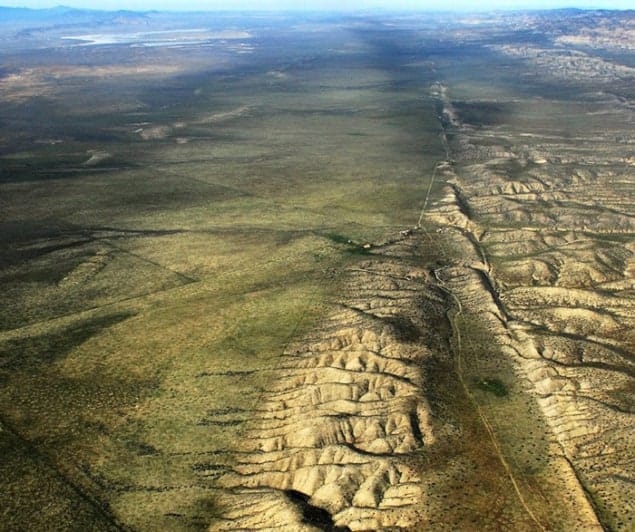
Earthquakes may be triggered by sound waves that reduce the friction between rocks at a geological fault. That is the conclusion of an international team of researchers that has done laboratory-based experiments that mimic the process. The results support the “acoustic fluidization” theory of earthquake triggering, which seeks to explain the unexpected weakness of some faults. The research could also help to reveal how aftershocks are generated at great distances from the earthquakes that precede them.
Large earthquakes are often followed by a number of smaller tremors – called aftershocks – that can occur in geological faults thousands of kilometres from the epicentre of the original earthquake. While aftershocks are well documented, exactly how they are triggered remains a mystery.
The theory of acoustic fluidization suggests that the seismic waves generated by the initial earthquake could create sonic vibrations that help to trigger subsequent fault movements. These vibrations affect the small grains of rock at the interface between two plates at a fault. The idea is that the vibrations cause the grains to behave collectively like a fluid, lowering friction in the granular material and causing the plates to slip past each other.
Bed of grains
In their new study, the researchers used a simulated fault system to investigate whether acoustic waves may indeed be able to trigger earthquakes. Their model fault was composed of two rough, pressed-together plates, between which lay a bed of spherical grains.
When a shear stress was applied to the model system, the researchers observed the fault undergo periodic slips, as expected. Sound waves at certain frequencies were then fired at the system and this caused the fault movements to occur much sooner than when no sound was applied. The team also found that the premature slips were more likely to occur with sound waves at a characteristic range of resonant frequencies corresponding to waves bouncing back-and-forth within the fault. This observation is in line with acoustic-fluidization theory.
“Acoustic fluidization reduces the confining pressure and the system becomes abruptly unstable, promoting a transition to an unjammed fluid-like state,” explains team member Eugenio Lippiello of the Second University of Naples. “When this occurs, an earthquake nucleates.”
Spontaneous sound
Lippiello and colleagues also discovered that the same resonant sound waves emerge spontaneously from the model fault, even when no external sound is applied. This happens a short time before a fault movement. “Even in the stick phase [when the fault is motionless], the granular medium is never in a frozen state,” says Lippiello. Instead, each grain oscillates weakly around its own centre and the sound waves are generated “when oscillations of individual particles synchronize to the resonant frequency”. Accordingly, acoustic fluidization may also help to explain why the measured rate of slips on real-life faults is higher than would be anticipated, based on studies of rock-on-rock friction.
“This work moves forward the idea that the surprising weakness observed on faults during earthquakes is caused by strong vibrations close to the fault plane,” comments Jay Melosh of Purdue University, who originally proposed the acoustic-fluidization process but was not involved in this study. “These waves are generated in the core of the fault as sliding starts and – just as a car moving too fast over a rough road can skid uncontrollably – the vibrations briefly offload the normal friction and allow the fault to slide as if it were greased.” Melosh commends the team for demonstrating the effectiveness of acoustic fluidization in faults with a granular core.
Other trigger candidates
However, Emily Brodsky of the University of California, Santa Cruz, remains cautious about the results. Brodsky, who was not involved in the study, points out that there are many candidate mechanisms for triggering aftershocks. “I am not sure that the observational evidence thus far supports the assertions about acoustic fluidization being the relevant mechanism for earthquake triggering by seismic waves,” she says.
With their initial study complete, the researchers are now looking to explore in more detail the mechanism through which the grain oscillations are synchronized. At the same time, the team is also planning to explore the role of heterogeneities in granular material on the overall behaviour of the fault system.
The research is described in Physical Review Letters.



